THE ICONS OF AFRICA
NOTE; WE HAVE CURRENTLY DECIDED TO BOYCOTT ALL TOURS TO TANZANIA IN THE LIGHT OF THAT COUNTRY ALLOWING THE TROPHY HUNTING OF SOME OF THE LAST REMAINING BIG TUSKER ELEPHANTS ON EARTH
Two of the most iconic safari destinations in Africa are undoubtedly the Serengeti National Park and Ngorongoro Crater.
Join Daryl & Sharna Balfour or Pierre Burton on this special departure in March-April 2024 or 2025 to take in two different areas of the southern Serengeti's short-grass plains during the annual birthing season of the wildebeest migration, as well as the spectacular Ngorongoro Crater. This safari will also include a stop at the famous anthropological site Olduvai Gorge, the Cradle of Mankind, where so many of our prehistoric hominid fossil records were found.
The tour starts in the safari capital of Tanzania, the bustling town of Arusha, with a night in a comfortable lodge on the Usa River after your international flight arrives at the nearby Kilimanjaro International Airport (most flights arrive at night.)
From here the next day we take a flight over the Ngorongoro highlands before dipping down towards the expansive plains of the Serengeti, for five nights in a seasonal/mobile tented camp in the Ndutu region of the southern Serengeti. At this time of year the plains around us should be reverberating with the sounds of hundreds of thousands of wildebeest and their newborn young…and of course the predators that keep them in their sights.
CHEETAH, LIONS, LEOPARDS - and GNUS!
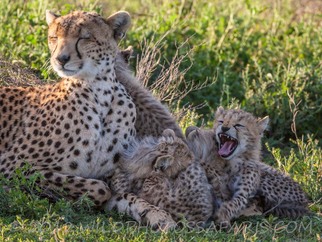
The Serengeti is renowned for its cheetahs and cubs.
At this time of year the southern Serengeti reverberates with the gnu-ing of the wildebeest, for it is the time of renewal when as many as half a million baby wildebeest are born. This in turn attracts the predators and we are likely to see cheetahs, lions and leopard (if we are lucky) as well as hyaenas and jackals on the open plains.
With luck we will also watch one of the wonders of the natural world - wildebeest giving birth. The newborn calf will rise to its feet and walk with the herd within 5 minutes of being born!
With luck we will also watch one of the wonders of the natural world - wildebeest giving birth. The newborn calf will rise to its feet and walk with the herd within 5 minutes of being born!
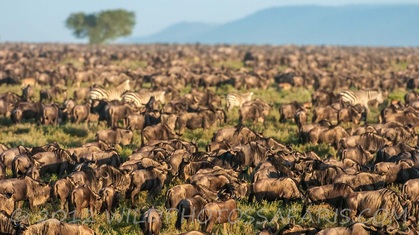
The Serengeti plains should be teeming with the massed herds of wildebeest.
I have enjoyed some of my best photographic days here in the southern Serengeti, and my record of 18 cheetahs in one drive was set here!
We will spend long hours in the company of both predators and prey and with luck could see numerous chases and kills!
We will spend long hours in the company of both predators and prey and with luck could see numerous chases and kills!
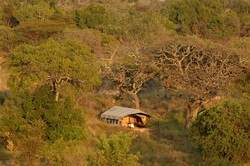
The tents are secluded under shady acacia trees.
Ndutu is located on the edge of Lake Ndutu with the smaller Lake Masek nearby. I have photographed some wonderful crossings of these lakes in the past, with both wildebeest and zebras streaming through the shallow waters. I usually time these safaris to be a little late rather than too early. Much like with human mothers, it is difficult to predict the exact date of birth…perhaps with wildebeest it is a bit more difficult - they don't have regular check-ups with the obstetrician! So with the births likely to happen anytime from February until early April, I prefer to time these safari so that we are more likely to find mothers and newly born calves than just a bunch of pregnant wildebeest! With luck by late March many of the calves will have been born and there will be thousands of tiny babies about and there could still be the occasional birth among the herds too.
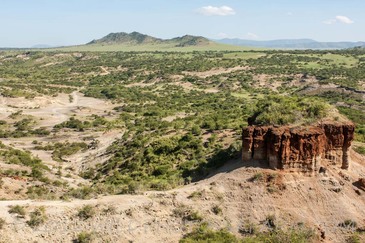
What is almost a certainty is that we are likely to encounter wildebeest in their tens if not hundreds of thousands, gathering on these nutritious short-grass plains while they let the newborn gain strength and they fatten up for the start of their long trek, the migration, to the north. Of course, the migration is a continuous cycle of life - but if there is a beginning, this is it…the time of birth right here in the southern Serengeti, a cycle that for some will end in the Maasai Mara later in the year.
After three nights under canvas in the Serengeti we pack our bags for the next leg of this adventure, driving across the plains in our custom 4x4 to the famous Olduvai Gorge (left) (more correctly Oldupai, the Maasai name for the sanseviera plant that grown prolifically here, and gives the gorge its name.) This is where, among others, the acclaimed palaeo-anthropologists Louis & Mary Leaky made many startling discoveries in the deep fossil beds…indeed, this is where our early ancestors probably stood on their hind legs and walked the plains for the first time!
After three nights under canvas in the Serengeti we pack our bags for the next leg of this adventure, driving across the plains in our custom 4x4 to the famous Olduvai Gorge (left) (more correctly Oldupai, the Maasai name for the sanseviera plant that grown prolifically here, and gives the gorge its name.) This is where, among others, the acclaimed palaeo-anthropologists Louis & Mary Leaky made many startling discoveries in the deep fossil beds…indeed, this is where our early ancestors probably stood on their hind legs and walked the plains for the first time!
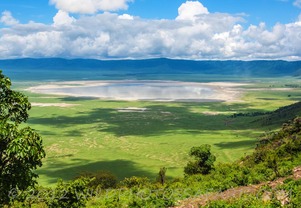
After a brief lecture by one of the resident historians at the small museum here we will continue on our way up into the Ngorongoro highlands, leaving behind the endless plains of the Serengeti. After a picnic lunch en route we crest the crown of the crater rim and look down (right) into one of the natural wonders of the world…the 100 square miles volcanic caldera that forms the Ngorongoro Crater, home to myriad animals and birds and one of the most spectacular & beautiful wildlife areas you are ever likely to experience.
We will arrive at the entrance to the Crater, the top of the Seneto Descent road, in time to spend a full afternoon on the Crater Floor. Here we will seek out Ngorongoro's famous big bull elephants, some of them carrying the biggest ivory you are likely to see anywhere (below left). Interestingly, cow herd, or breeding herds, do not go down to the Crater floor as the steep tracks on the inner walls are too difficult for small calves to negotiate.
We will arrive at the entrance to the Crater, the top of the Seneto Descent road, in time to spend a full afternoon on the Crater Floor. Here we will seek out Ngorongoro's famous big bull elephants, some of them carrying the biggest ivory you are likely to see anywhere (below left). Interestingly, cow herd, or breeding herds, do not go down to the Crater floor as the steep tracks on the inner walls are too difficult for small calves to negotiate.
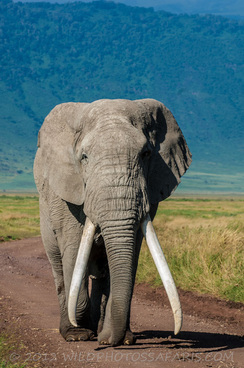
Also in the Crater are a number of black rhinoceros, this is perhaps one of the best places in Africa today in which to see them in the wild - a privilege that may not be around for future generations, at the current rate they are being poached for traditional Chinese medicines.
We spend two nights at the rustic old Ngorongoro Sopa Lodge, a choice dictated by its location above anything else. Situated on the eastern rim of the Crater it has the best views of any establishment in Ngorongoro, but more than that, it has its own track into and out of the Crater, allowing us the chance to be the first down into the Crater in the morning, and among the last to leave in the evenings. We will endeavour in fact to be the first out in the morning, for in the Crater the old saying "the early bird gets the worm" could not be truer. As one of the most iconic safari destinations of them all the Crater does attract large numbers of tourists (much like the Eiffel Tower does in Paris, but you would not dream of not checking it out on your first visit to France) but the majority of vehicles only start filtering into the Crater later in the morning, after a leisurely breakfast at their lodge!
An early arrival in the Crater assures us of a better chance of finding black rhinos close to the roads (below), lions out and active, and , if we're lucky, a leopard still on the prowl.
The Crater abounds with wildlife, and we will enjoy great viewing too of zebras, buffalo, wildebeest, hyenas and gazelles.
We spend two nights at the rustic old Ngorongoro Sopa Lodge, a choice dictated by its location above anything else. Situated on the eastern rim of the Crater it has the best views of any establishment in Ngorongoro, but more than that, it has its own track into and out of the Crater, allowing us the chance to be the first down into the Crater in the morning, and among the last to leave in the evenings. We will endeavour in fact to be the first out in the morning, for in the Crater the old saying "the early bird gets the worm" could not be truer. As one of the most iconic safari destinations of them all the Crater does attract large numbers of tourists (much like the Eiffel Tower does in Paris, but you would not dream of not checking it out on your first visit to France) but the majority of vehicles only start filtering into the Crater later in the morning, after a leisurely breakfast at their lodge!
An early arrival in the Crater assures us of a better chance of finding black rhinos close to the roads (below), lions out and active, and , if we're lucky, a leopard still on the prowl.
The Crater abounds with wildlife, and we will enjoy great viewing too of zebras, buffalo, wildebeest, hyenas and gazelles.
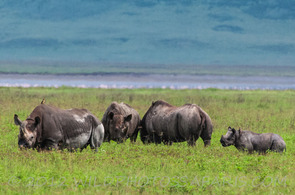
After two nights at the Sopa Lodge - we will perhaps spend a full day in the Crater itself on our last day there - we will make our way by road back to Arusha in time for curio shopping and lunch en route, and the chance to shop for precious gemstones such as Tanzanite and Tsavorite in Arusha itself (I have a great wholesale trader for bargain deals). Most international flights leave Kilimanjaro International in the evening, so we will make our way directly to the airport for these connections.
The fully inclusive cost of this safari, from Kilimanjaro International Airport (international flights are for your own account) is US$-TBC per person sharing. The safari is for four persons only, or multiples of four.
Not included are your flights to & from Tanzania from your home country, visa fees ($100 per person for most nationalities), tips & gratuities, drinks and laundry at hotels such as River Trees in Arusha (first night) and the Ngorongoro Sopa lodge, and items of a personal nature.
Please contact us soon to avoid disappointment if you are interested in joining us on this classic Icons of Africa safari as we expect it will sell out quickly. Enquire now about this safari for 2025 or once Tanzania changes its trophy hunting policies!
The fully inclusive cost of this safari, from Kilimanjaro International Airport (international flights are for your own account) is US$-TBC per person sharing. The safari is for four persons only, or multiples of four.
Not included are your flights to & from Tanzania from your home country, visa fees ($100 per person for most nationalities), tips & gratuities, drinks and laundry at hotels such as River Trees in Arusha (first night) and the Ngorongoro Sopa lodge, and items of a personal nature.
Please contact us soon to avoid disappointment if you are interested in joining us on this classic Icons of Africa safari as we expect it will sell out quickly. Enquire now about this safari for 2025 or once Tanzania changes its trophy hunting policies!
